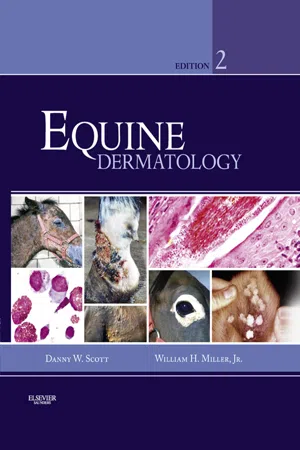
- 552 pages
- English
- ePUB (mobile friendly)
- Available on iOS & Android
Equine Dermatology - E-Book
About this book
Diagnose, treat, and manage equine skin disorders with the most comprehensive reference available! With 900 full-color photos, Equine Dermatology covers skin diseases ranging from those that merely annoy the horse to others that interfere with the horse's ability to function in riding, working, or show. Thorough coverage includes essential basics and practical diagnostic methods, therapies, and specific abnormalities and defects. The book describes the structure and function of the skin, and discusses disorders including bacterial, fungal, parasitic, viral, protozoal, allergic, immune-mediated, endocrine, metabolic, and nutritional diseases. It also covers congenital and hereditary defects, pigmentation abnormalities, keratinization defects, environmental skin diseases, and skin tumors. Written by renowned equine dermatologists Danny Scott and Bill Miller, this all-inclusive resource covers the latest dermatologic topics and the newest therapies.- Current, comprehensive coverage includes every known equine dermatosis.- An emphasis on differential diagnosis includes key differentials and breed predilections for each disease, especially helpful when you have only a specimen and an incomplete history to work with.- A consistent format makes it easy to locate information on each skin disorder, including a clinical description, its cause and pathogenesis, clinical features, clinical management, diagnosis, treatment, and any zoonotic aspects.- Expert authors Danny W. Scott, DVM, and William H. Miller, Jr., VMD, offer years of knowledge, experience, and their vast image collections.- Diagnostic tables in each chapter provide a quick reference for identifying lesions and disorders.- An extensive list of references at the end of each chapter includes recommendations for further reading.- New coverage of dermatologic conditions includes the latest topics and emerging disorders such as chronic progressive lymphedema, herpesvirus-2-associated dermatitis, salmonella-associated dermatoses, and nodular auricular chondropathy.- Updated Diagnostic Methods chapter covers multiple methods of developing a differential diagnosis list based on breed, lesion type, patterns, and location.- A focus on common clinical problems highlights the conditions most likely to be seen in practice.- Almost 1, 000 full-color photos of skin disorders make it easy to distinguish clinical characteristics and variations of normal and abnormal for accurate diagnosis and therapy.
Frequently asked questions
- Essential is ideal for learners and professionals who enjoy exploring a wide range of subjects. Access the Essential Library with 800,000+ trusted titles and best-sellers across business, personal growth, and the humanities. Includes unlimited reading time and Standard Read Aloud voice.
- Complete: Perfect for advanced learners and researchers needing full, unrestricted access. Unlock 1.4M+ books across hundreds of subjects, including academic and specialized titles. The Complete Plan also includes advanced features like Premium Read Aloud and Research Assistant.
Please note we cannot support devices running on iOS 13 and Android 7 or earlier. Learn more about using the app.
Information
General functions and properties of the skin
Ontogeny
Table of contents
- Cover
- Title Page
- Front matter
- Copyright
- Preface
- Acknowledgments
- Preface and Acknowledgments from the First Edition
- Table of Contents
- Chapter 1: Structure and Function of the Skin
- Chapter 2: Diagnostic Methods
- Chapter 3: Dermatologic Therapy
- Chapter 4: Bacterial Skin Diseases
- Chapter 5: Fungal Skin Diseases
- Chapter 6: Parasitic Diseases
- Chapter 7: Viral and Protozoal Skin Diseases
- Chapter 8: Skin Immune System and Allergic Skin Diseases
- Chapter 9: Immune-Mediated Disorders
- Chapter 10: Endocrine, Nutritional, and Miscellaneous Hair Coat Disorders
- Chapter 11: Keratinization Defects
- Chapter 12: Pigmentary Abnormalities
- Chapter 13: Environmental Skin Diseases
- Chapter 14: Congenital and Hereditary Skin Diseases
- Chapter 15: Miscellaneous Skin Diseases
- Chapter 16: Neoplasms, Cysts, Hamartomas, and Keratoses
- Index